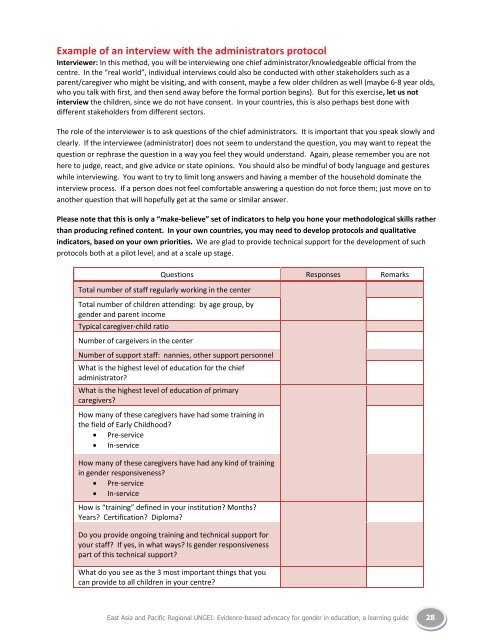Evidence-Based Advocacy - United Nations Girls' Education Initiative
Evidence-Based Advocacy - United Nations Girls' Education Initiative
Evidence-Based Advocacy - United Nations Girls' Education Initiative
Create successful ePaper yourself
Turn your PDF publications into a flip-book with our unique Google optimized e-Paper software.
Example of an interview with the administrators protocol<br />
Interviewer: In this method, you will be interviewing one chief administrator/knowledgeable official from the<br />
centre. In the “real world”, individual interviews could also be conducted with other stakeholders such as a<br />
parent/caregiver who might be visiting, and with consent, maybe a few older children as well (maybe 6-8 year olds,<br />
who you talk with first, and then send away before the formal portion begins). But for this exercise, let us not<br />
interview the children, since we do not have consent. In your countries, this is also perhaps best done with<br />
different stakeholders from different sectors.<br />
The role of the interviewer is to ask questions of the chief administrators. It is important that you speak slowly and<br />
clearly. If the interviewee (administrator) does not seem to understand the question, you may want to repeat the<br />
question or rephrase the question in a way you feel they would understand. Again, please remember you are not<br />
here to judge, react, and give advice or state opinions. You should also be mindful of body language and gestures<br />
while interviewing. You want to try to limit long answers and having a member of the household dominate the<br />
interview process. If a person does not feel comfortable answering a question do not force them; just move on to<br />
another question that will hopefully get at the same or similar answer.<br />
Please note that this is only a “make-believe” set of indicators to help you hone your methodological skills rather<br />
than producing refined content. In your own countries, you may need to develop protocols and qualitative<br />
indicators, based on your own priorities. We are glad to provide technical support for the development of such<br />
protocols both at a pilot level, and at a scale up stage.<br />
Questions Responses Remarks<br />
Total number of staff regularly working in the center<br />
Total number of children attending: by age group, by<br />
gender and parent income<br />
Typical caregiver-child ratio<br />
Number of cargeivers in the center<br />
Number of support staff: nannies, other support personnel<br />
What is the highest level of education for the chief<br />
administrator?<br />
What is the highest level of education of primary<br />
caregivers?<br />
How many of these caregivers have had some training in<br />
the field of Early Childhood?<br />
Pre-service<br />
In-service<br />
How many of these caregivers have had any kind of training<br />
in gender responsiveness?<br />
Pre-service<br />
In-service<br />
How is “training” defined in your institution? Months?<br />
Years? Certification? Diploma?<br />
Do you provide ongoing training and technical support for<br />
your staff? If yes, in what ways? Is gender responsiveness<br />
part of this technical support?<br />
What do you see as the 3 most important things that you<br />
can provide to all children in your centre?<br />
East Asia and Pacific Regional UNGEI: <strong>Evidence</strong>-based advocacy for gender in education, a learning guide 28

















